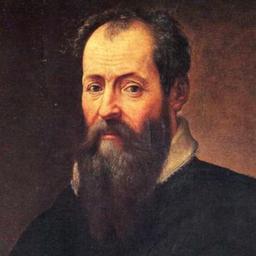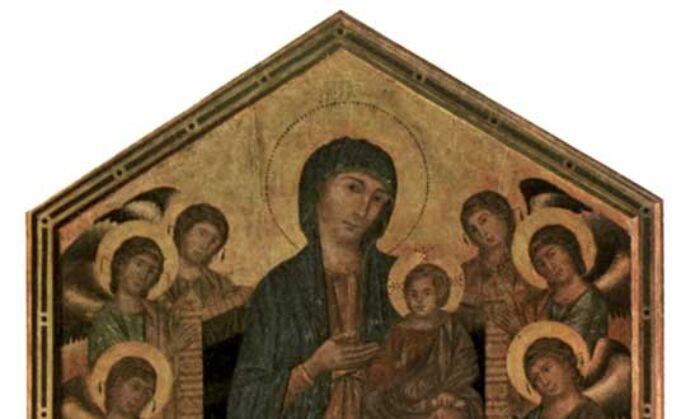The greatest gifts are often seen, in the course of nature, rained by celestial influences on human creatures; and sometimes, in supernatural fashion, beauty, grace, and talent are united beyond measure in one single person, in a manner that to whatever such an one turns his attention, his every action is so divine, that, surpassing all other men, it makes itself clearly known as a thing bestowed by God (as it is), and not acquired by human art. This was seen by all mankind in Leonardo da Vinci, in whom, besides a beauty of body never sufficiently extolled, there was an infinite grace in all his actions; and so great was his genius, and such its growth, that to whatever difficulties he turned his mind, he solved them with ease. In him was great bodily strength, joined to dexterity, with a spirit and courage ever royal and magnanimous; and the fame of his name so increased, that not only in his lifetime was he held in esteem, but his reputation became even greater among posterity after his death.
Truly marvellous and celestial was Leonardo, the son of Ser Piero da Vinci; and in learning and in the rudiments of letters he would have made great proficience, if he had not been so variable and unstable, for he set himself to learn many things, and then, after having begun them, abandoned them. Thus, in arithmetic, during the few months that he studied it, he made so much progress, that, by continually suggesting
doubts and difficulties to the master who was teaching him, he would very often bewilder him. He gave some little attention to music, and quickly resolved to learn to play the lyre, as one who had by nature a spirit most lofty and full of refinement: wherefore he sang divinely to that instrument, improvising upon it. Nevertheless, although he occupied himself with such a variety of things, he never ceased drawing and working in relief, pursuits which suited his fancy more than any other. Ser Piero, having observed this, and having considered the loftiness of his intellect, one day took some of his drawings and carried them to Andrea del Verrocchio, who was much his friend, and besought him straitly to tell him whether Leonardo, by devoting himself to drawing, would make any proficience. Andrea was astonished to see the extraordinary beginnings of Leonardo, and urged Ser Piero that he should make him study it; wherefore he arranged with Leonardo that he should enter the workshop of Andrea, which Leonardo did with the greatest willingness in the world. And he practised not one branch of art only, but all those in which drawing played a part; and having an intellect so divine and marvellous that he was also an excellent geometrician, he not only worked in sculpture, making in his youth, in clay, some heads of women that are smiling, of which plaster casts are still taken, and likewise some heads of boys which appeared to have issued from the hand of a master; but in architecture, also, he made many drawings both of ground-plans and of other designs of buildings; and he was the first, although but a youth, who suggested the plan of reducing the river Arno to a navigable canal from Pisa to Florence. He made designs of flour-mills, fulling-mills, and engines, which might be driven by the force of water: and since he wished that his profession should be painting, he studied much in drawing after nature, and sometimes in making models of figures in clay, over which he would lay soft pieces of cloth dipped in clay, and then set himself patiently to draw them on a certain kind of very fine Rheims cloth, or prepared linen: and he executed them in black and white with the point of his brush, so that it was a marvel, as some of them by his hand, which I have in our book of drawings, still bear witness; besides which, he drew on paper with such diligence and so well, that there is
no one who has ever equalled him in perfection of finish; and I have one, a head drawn with the style in chiaroscuro, which is divine.
And there was infused in that brain such grace from God, and a power of expression in such sublime accord with the intellect and memory that served it, and he knew so well how to express his conceptions by draughtsmanship, that he vanquished with his discourse, and confuted with his reasoning, every valiant wit. And he was continually making models and designs to show men how to remove mountains with ease, and how to bore them in order to pass from one level to another; and by means of levers, windlasses, and screws, he showed the way to raise and draw great weights, together with methods for emptying harbours, and pumps for removing water from low places, things which his brain never ceased from devising; and of these ideas and labours many drawings may be seen, scattered abroad among our craftsmen; and I myself have seen not a few. He even went so far as to waste his time in drawing knots of cords, made according to an order, that from one end all the rest might follow till the other, so as to fill a round; and one of these is to be seen in stamp, most difficult and beautiful, and in the middle of it are these words, “Leonardus Vinci Accademia.” And among these models and designs, there was one by which he often demonstrated to many ingenious citizens, who were then governing Florence, how he proposed to raise the Temple of S. Giovanni in Florence, and place steps under it, without damaging the building; and with such strong reasons did he urge this, that it appeared possible, although each man, after he had departed, would recognize for himself the impossibility of so vast an undertaking.
He was so pleasing in conversation, that he attracted to himself the hearts of men. And although he possessed, one might say, nothing, and worked little, he always kept servants and horses, in which latter he took much delight, and particularly in all other animals, which he managed with the greatest love and patience; and this he showed when often passing by the places where birds were sold, for, taking them with his own hand out of their cages, and having paid to those who sold them the price that was asked, he let them fly away into the air, restoring to
them their lost liberty. For which reason nature was pleased so to favour him, that, wherever he turned his thought, brain, and mind, he displayed such divine power in his works, that, in giving them their perfection, no one was ever his peer in readiness, vivacity, excellence, beauty, and grace.
It is clear that Leonardo, through his comprehension of art, began many things and never finished one of them, since it seemed to him that the hand was not able to attain to the perfection of art in carrying out the things which he imagined; for the reason that he conceived in idea difficulties so subtle and so marvellous, that they could never be expressed by the hands, be they ever so excellent. And so many were his caprices, that, philosophizing of natural things, he set himself to seek out the properties of herbs, going on even to observe the motions of the heavens, the path of the moon, and the courses of the sun.
He was placed, then, as has been said, in his boyhood, at the instance of Ser Piero, to learn art with Andrea del Verrocchio, who was making a panel-picture of S. John baptizing Christ, when Leonardo painted an angel who was holding some garments; and although he was but a lad, Leonardo executed it in such a manner that his angel was much better than the figures of Andrea; which was the reason that Andrea would never again touch colour, in disdain that a child should know more than he.
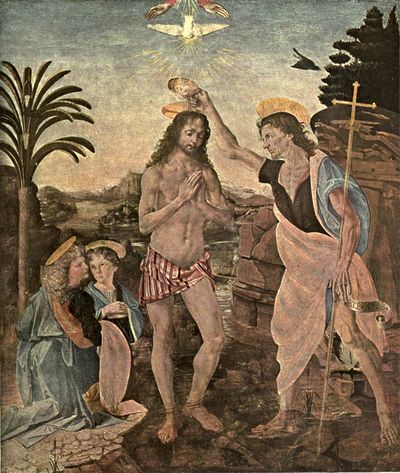
Andrea Verrocchio: The Baptism in Jordan
(Florence: Accademia, 71. Panel)
He was commissioned to make a cartoon for a door-hanging that was to be executed in Flanders, woven in gold and silk, to be sent to the King of Portugal, of Adam and Eve sinning in the Earthly Paradise; wherein Leonardo drew with the brush in chiaroscuro, with the lights in lead-white, a meadow of infinite kinds of herbage, with some animals, of which, in truth, it may be said that for diligence and truth to nature divine wit could not make it so perfect. In it is the fig-tree, together with the foreshortening of the leaves and the varying aspects of the branches, wrought with such lovingness that the brain reels at the mere thought how a man could have such patience. There is also a palm-tree which has the radiating crown of the palm, executed with such great and marvellous art that nothing save the patience and intellect of Leonardo could avail to do it. This work was carried no farther; wherefore the cartoon is now at Florence, in the blessed house of the Magnificent
Ottaviano de' Medici, presented to him not long ago by the uncle of Leonardo.
It is said that Ser Piero da Vinci, being at his villa, was besought as a favour, by a peasant of his, who had made a buckler with his own hands out of a fig-tree that he had cut down on the farm, to have it painted for him in Florence, which he did very willingly, since the countryman was very skilful at catching birds and fishing, and Ser Piero made much use of him in these pursuits. Thereupon, having had it taken to Florence, without saying a word to Leonardo as to whose it was, he asked him to paint something upon it. Leonardo, having one day taken this buckler in his hands, and seeing it twisted, badly made, and clumsy, straightened it by the fire, and, having given it to a turner, from the rude and clumsy thing that it was, caused it to be made smooth and even. And afterwards, having given it a coat of gesso, and having prepared it in his own way, he began to think what he could paint upon it, that might be able to terrify all who should come upon it, producing the same effect as once did the head of Medusa. For this purpose, then, Leonardo carried to a room of his own into which no one entered save himself alone, lizards great and small, crickets, serpents, butterflies, grasshoppers, bats, and other strange kinds of suchlike animals, out of the number of which, variously put together, he formed a great ugly creature, most horrible and terrifying, which emitted a poisonous breath and turned the air to flame; and he made it coming out of a dark and jagged rock, belching forth venom from its open throat, fire from its eyes, and smoke from its nostrils, in so strange a fashion that it appeared altogether a monstrous and horrible thing; and so long did he labour over making it, that the stench of the dead animals in that room was past bearing, but Leonardo did not notice it, so great was the love that he bore towards art. The work being finished, although it was no longer asked for either by the countryman or by his father, Leonardo told the latter that he might send for the buckler at his convenience, since, for his part, it was finished. Ser Piero having therefore gone one morning to the room for the buckler, and having knocked at the door, Leonardo opened to him, telling him to wait a little; and, having gone back into the room, he adjusted the
buckler in a good light on the easel, and put to the window, in order to make a soft light, and then he bade him come in to see it. Ser Piero, at the first glance, taken by surprise, gave a sudden start, not thinking that that was the buckler, nor merely painted the form that he saw upon it, and, falling back a step, Leonardo checked him, saying, “This work serves the end for which it was made; take it, then, and carry it away, since this is the effect that it was meant to produce.” This thing appeared to Ser Piero nothing short of a miracle, and he praised very greatly the ingenious idea of Leonardo; and then, having privately bought from a pedlar another buckler, painted with a heart transfixed by an arrow, he presented it to the countryman, who remained obliged to him for it as long as he lived. Afterwards, Ser Piero sold the buckler of Leonardo secretly to some merchants in Florence, for a hundred ducats; and in a short time it came into the hands of the Duke of Milan, having been sold to him by the said merchants for three hundred ducats.
Leonardo then made a picture of Our Lady, a most excellent work, which was in the possession of Pope Clement VII; and, among other things painted therein, he counterfeited a glass vase full of water, containing some flowers, in which, besides its marvellous naturalness, he had imitated the dew-drops on the flowers, so that it seemed more real than the reality. For Antonio Segni, who was very much his friend, he made, on a sheet of paper, a Neptune executed with such careful draughtsmanship that it seemed absolutely alive. In it one saw the ocean troubled, and Neptune’s car drawn by sea-horses, with fantastic creatures, marine monsters and winds, and some very beautiful heads of sea-gods. This drawing was presented by Fabio, the son of Antonio, to Messer Giovanni Gaddi, with this epigram:
Pinxit Virgilius Neptunum, pinxit Homerus,
Dum maris undisoni per vada flectit equos.
Mente quidem vates illum conspexit uterque,
Vincius ast oculis; jureque vincit eos.
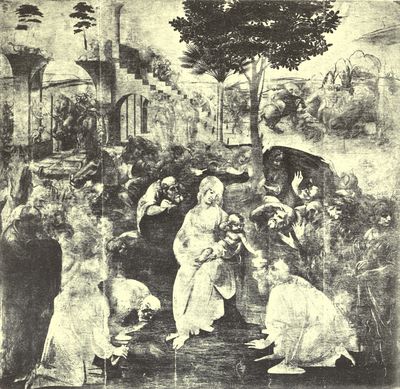
The Adoration of The Magi
(After the panel by Leonardo da Vinci. Florence: Uffizi, 1252)
Anderson
The fancy came to him to paint a picture in oils of the head of a Medusa, with the head attired with a coil of snakes, the most strange
and extravagant invention that could ever be imagined; but since it was a work that took time, it remained unfinished, as happened with almost all his things. It is among the rare works of art in the Palace of Duke Cosimo, together with the head of an angel, who is raising one arm in the air, which, coming forward, is foreshortened from the shoulder to the elbow, and with the other he raises the hand to the breast.
It is an extraordinary thing how that genius, in his desire to give the highest relief to the works that he made, went so far with dark shadows, in order to find the darkest possible grounds, that he sought for blacks which might make deeper shadows and be darker than other blacks, that by their means he might make his lights the brighter; and in the end this method turned out so dark, that, no light remaining there, his pictures had rather the character of things made to represent an effect of night, than the clear quality of daylight; which all came from seeking to give greater relief, and to achieve the final perfection of art.
He was so delighted when he saw certain bizarre heads of men, with the beard or hair growing naturally, that he would follow one that pleased him a whole day, and so treasured him up in idea, that afterwards, on arriving home, he drew him as if he had had him in his presence. Of this sort there are many heads to be seen, both of women and of men, and I have several of them, drawn by his hand with the pen, in our book of drawings, which I have mentioned so many times; such was that of Amerigo Vespucci, which is a very beautiful head of an old man drawn with charcoal, and likewise that of Scaramuccia, Captain of the Gypsies, which afterwards came into the hands of M. Donato Valdambrini of Arezzo, Canon of S. Lorenzo, left to him by Giambullari.
He began a panel-picture of the Adoration of the Magi, containing many beautiful things, particularly the heads, which was in the house of Amerigo Benci, opposite the Loggia de' Peruzzi; and this, also, remained unfinished, like his other works.
It came to pass that Giovan Galeazzo, Duke of Milan, being dead, and Lodovico Sforza raised to the same rank, in the year 1494, Leonardo was summoned to Milan in great repute to the Duke, who took much delight in the sound of the lyre, to the end that he might play it: and
Leonardo took with him that instrument which he had made with his own hands, in great part of silver, in the form of a horse’s skull—a thing bizarre and new—in order that the harmony might be of greater volume and more sonorous in tone; with which he surpassed all the musicians who had come together there to play. Besides this, he was the best improviser in verse of his day. The Duke, hearing the marvellous discourse of Leonardo, became so enamoured of his genius, that it was something incredible: and he prevailed upon him by entreaties to paint an altar-panel containing a Nativity, which was sent by the Duke to the Emperor.
He also painted in Milan, for the Friars of S. Dominic, at S. Maria delle Grazie, a Last Supper, a most beautiful and marvellous thing; and to the heads of the Apostles he gave such majesty and beauty, that he left the head of Christ unfinished, not believing that he was able to give it that divine air which is essential to the image of Christ. This work, remaining thus all but finished, has ever been held by the Milanese in the greatest veneration, and also by strangers as well; for Leonardo imagined and succeeded in expressing that anxiety which had seized the Apostles in wishing to know who should betray their Master. For which reason in all their faces are seen love, fear, and wrath, or rather, sorrow, at not being able to understand the meaning of Christ; which thing excites no less marvel than the sight, in contrast to it, of obstinacy, hatred, and treachery in Judas; not to mention that every least part of the work displays an incredible diligence, seeing that even in the tablecloth the texture of the stuff is counterfeited in such a manner that linen itself could not seem more real.
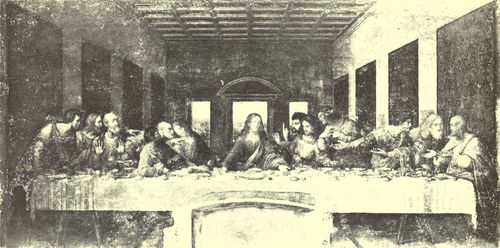
The Last Supper
(After the oil fresco by Leonardo da Vinci. Milan: S. Maria delle Grazie)
M.S.
It is said that the Prior of that place kept pressing Leonardo, in a most importunate manner, to finish the work; for it seemed strange to him to see Leonardo sometimes stand half a day at a time, lost in contemplation, and he would have liked him to go on like the labourers hoeing in his garden, without ever stopping his brush. And not content with this, he complained of it to the Duke, and that so warmly, that he was constrained to send for Leonardo and delicately urged him to work, contriving nevertheless to show him that he was doing all this because of the importunity of the Prior. Leonardo, knowing that the intellect of that Prince was acute and discerning, was pleased to discourse at large with the Duke on the subject, a thing which he had never done with the Prior: and he reasoned much with him about art, and made him understand that men of lofty genius sometimes accomplish the most when they work the least, seeking out inventions with the mind, and forming those perfect ideas which the hands afterwards express and reproduce from the images already conceived in the brain. And he added that two heads were still wanting for him to paint; that of Christ, which he did not wish to seek on earth; and he could not think that it was possible to conceive in the imagination that beauty and heavenly grace which should be the mark of God incarnate. Next, there was wanting that of Judas, which was also troubling him, not thinking himself capable of imagining features that should represent the countenance of him who, after so many benefits received, had a mind so cruel as to resolve to betray his Lord, the Creator of the world. However, he would seek out a model for the latter; but if in the end he could not find a better, he should not want that of the importunate and tactless Prior. This thing moved the Duke wondrously to laughter, and he said that Leonardo had a thousand reasons on his side. And so the poor Prior, in confusion, confined himself to urging on the work in the garden, and left Leonardo in peace, who finished only the head of Judas, which seems the very embodiment of treachery and inhumanity; but that of Christ, as has been said, remained unfinished. The nobility of this picture, both because of its design, and from its having been wrought with an incomparable diligence, awoke a desire in the King of France to transport it into his kingdom; wherefore he tried by all possible means to discover whether there were architects who, with cross-stays of wood and iron, might have been able to make it so secure that it might be transported safely; without considering any expense that might have been involved thereby, so much did he desire it. But the fact of its being painted on the wall robbed his Majesty of his desire; and the picture remained with the Milanese. In the same refectory, while he was working at the Last Supper, on the end wall where is a Passion in the old manner, Leonardo portrayed the said Lodovico, with Massimiliano, his eldest son; and, on the other side, the Duchess Beatrice, with Francesco, their other son, both of whom afterwards became Dukes of Milan; and all are portrayed divinely well.
While he was engaged on this work, he proposed to the Duke to make a horse in bronze, of a marvellous greatness, in order to place upon it, as a memorial, the image of the Duke. And on so vast a scale did he begin it and continue it, that it could never be completed. And there are those who have been of the opinion (so various and so often malign out of envy are the judgments of men) that he began it with no intention of finishing it, because, being of so great a size, an incredible difficulty was encountered in seeking to cast it in one piece; and it might also be believed that, from the result, many may have formed such a judgment, since many of his works have remained unfinished. But, in truth, one can believe that his vast and most excellent mind was hampered through being too full of desire, and that his wish ever to seek out excellence upon excellence, and perfection upon perfection, was the reason of it. “Tal che l' opera fosse ritardata dal desio,” as our Petrarca has said. And, indeed, those who saw the great model that Leonardo made in clay vow that they have never seen a more beautiful thing, or a more superb; and it was preserved until the French came to Milan with King Louis of France, and broke it all to pieces. Lost, also, is a little model of it in wax, which was held to be perfect, together with a book on the anatomy of the horse made by him by way of study.
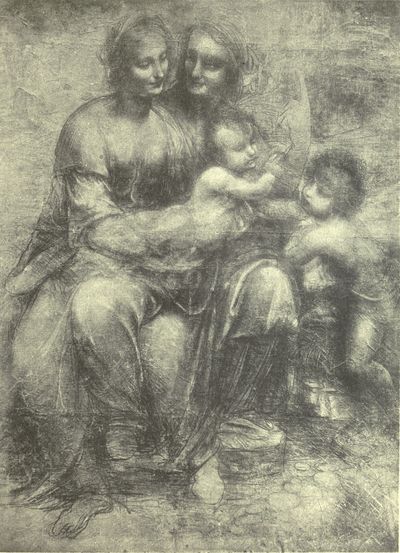
The Madonna and Child With S. Anne
(After the cartoon by Leonardo da Vinci.London: Burlington House)
Vasari Society
He then applied himself, but with greater care, to the anatomy of man, assisted by and in turn assisting, in this research, Messer Marc' Antonio della Torre, an excellent philosopher, who was then lecturing at Pavia, and who wrote of this matter; and he was one of the first (as I have heard tell) that began to illustrate the problems of medicine with the doctrine of Galen, and to throw true light on anatomy, which up to that time had been wrapped in the thick and gross darkness of ignorance. And in this he found marvellous aid in the brain, work, and hand of Leonardo, who made a book drawn in red chalk, and annotated with the pen, of the bodies that he dissected with his own hand, and drew with the greatest diligence; wherein he showed all the frame of the
bones; and then added to them, in order, all the nerves, and covered them with muscles; the first attached to the bone, the second that hold the body firm, and the third that move it; and beside them, part by part, he wrote in letters of an ill-shaped character, which he made with the left hand, backwards; and whoever is not practised in reading them cannot understand them, since they are not to be read save with a mirror. Of these papers on the anatomy of man, a great part is in the hands of Messer Francesco da Melzo, a gentleman of Milan, who in the time of Leonardo was a very beautiful boy, and much beloved by him, and now is a no less beautiful and gentle old man; and he holds them dear, and keeps such papers together as if they were relics, in company with the portrait of Leonardo of happy memory; and to all who read these writings, it seems impossible that that divine spirit should have discoursed so well of art, and of the muscles, nerves, and veins, and with such diligence of everything. So, also, there are in the hands of ——,
[11] a painter of Milan, certain writings of Leonardo, likewise in characters written with the left hand, backwards, which treat of painting, and of the methods of drawing and colouring. This man, not long ago, came to Florence to see me, wishing to print this work, and he took it to Rome, in order to put it into effect; but I do not know what may afterwards have become of it.
And to return to the works of Leonardo; there came to Milan, in his time, the King of France, wherefore Leonardo being asked to devise some bizarre thing, made a lion which walked several steps and then opened its breast, and showed it full of lilies.
In Milan he took for his assistant the Milanese Salai, who was most comely in grace and beauty, having fine locks, curling in ringlets, in which Leonardo greatly delighted; and he taught him many things of art; and certain works in Milan, which are said to be by Salai, were retouched by Leonardo.
He returned to Florence, where he found that the Servite Friars had entrusted to Filippino the painting of the panel for the high-altar of the Nunziata; whereupon Leonardo said that he would willingly have
done such a work. Filippino, having heard this, like the amiable fellow that he was, retired from the undertaking; and the friars, to the end that Leonardo might paint it, took him into their house, meeting the expenses both of himself and of all his household; and thus he kept them in expectation for a long time, but never began anything. In the end, he made a cartoon containing a Madonna and a S. Anne, with a Christ, which not only caused all the craftsmen to marvel, but, when it was finished, men and women, young and old, continued for two days to flock for a sight of it to the room where it was, as if to a solemn festival, in order to gaze at the marvels of Leonardo, which caused all those people to be amazed; for in the face of that Madonna was seen whatever of the simple and the beautiful can by simplicity and beauty confer grace on a picture of the Mother of Christ, since he wished to show that modesty and that humility which are looked for in an image of the Virgin, supremely content with gladness at seeing the beauty of her Son, whom she was holding with tenderness in her lap, while with most chastened gaze she was looking down at S. John, as a little boy, who was playing with a lamb; not without a smile from S. Anne, who, overflowing with joy, was beholding her earthly progeny become divine—ideas truly worthy of the brain and genius of Leonardo. This cartoon, as will be told below, afterwards went to France. He made a portrait of Ginevra d' Amerigo Benci, a very beautiful work; and abandoned the work for the friars, who restored it to Filippino; but he, also, failed to finish it, having been overtaken by death.
Leonardo undertook to execute, for Francesco del Giocondo, the portrait of Monna Lisa, his wife; and after toiling over it for four years, he left it unfinished; and the work is now in the collection of King Francis of France, at Fontainebleau. In this head, whoever wished to see how closely art could imitate nature, was able to comprehend it with ease; for in it were counterfeited all the minutenesses that with subtlety are able to be painted, seeing that the eyes had that lustre and watery sheen which are always seen in life, and around them were all those rosy and pearly tints, as well as the lashes, which cannot be represented without the greatest subtlety. The eyebrows, through his having shown
the manner in which the hairs spring from the flesh, here more close and here more scanty, and curve according to the pores of the skin, could not be more natural. The nose, with its beautiful nostrils, rosy and tender, appeared to be alive. The mouth, with its opening, and with its ends united by the red of the lips to the flesh-tints of the face, seemed, in truth, to be not colours but flesh. In the pit of the throat, if one gazed upon it intently, could be seen the beating of the pulse. And, indeed, it may be said that it was painted in such a manner as to make every valiant craftsman, be he who he may, tremble and lose heart. He made use, also, of this device: Monna Lisa being very beautiful, he always employed, while he was painting her portrait, persons to play or sing, and jesters, who might make her remain merry, in order to take away that melancholy which painters are often wont to give to the portraits that they paint. And in this work of Leonardo’s there was a smile so pleasing, that it was a thing more divine than human to behold; and it was held to be something marvellous, since the reality was not more alive.
By reason, then, of the excellence of the works of this most divine craftsman, his fame had so increased that all persons who took delight in art—nay, the whole city of Florence—desired that he should leave them some memorial, and it was being proposed everywhere that he should be commissioned to execute some great and notable work, whereby the commonwealth might be honoured and adorned by the great genius, grace and judgment that were seen in the works of Leonardo. And it was decided between the Gonfalonier and the chief citizens, the Great Council Chamber having been newly built—the architecture of which had been contrived with the judgment and counsel of Giuliano da San Gallo, Simone Pollaiuolo, called Il Cronaca, Michelagnolo Buonarroti, and Baccio d' Agnolo, as will be related with more detail in the proper places—and having been finished in great haste, it was ordained by public decree that Leonardo should be given some beautiful work to paint; and so the said hall was allotted to him by Piero Soderini, then Gonfalonier of Justice. Whereupon Leonardo, determining to execute this work, began a cartoon in the Sala del Papa, an apartment in S. Maria Novella, representing the story of Niccolò Piccinino, Captain of Duke
Filippo of Milan; wherein he designed a group of horsemen who were fighting for a standard, a work that was held to be very excellent and of great mastery, by reason of the marvellous ideas that he had in composing that battle; seeing that in it rage, fury, and revenge are perceived as much in the men as in the horses, among which two with the fore-legs interlocked are fighting no less fiercely with their teeth than those who are riding them do in fighting for that standard, which has been grasped by a soldier, who seeks by the strength of his shoulders, as he spurs his horse to flight, having turned his body backwards and seized the staff of the standard, to wrest it by force from the hands of four others, of whom two are defending it, each with one hand, and, raising their swords in the other, are trying to sever the staff; while an old soldier in a red cap, crying out, grips the staff with one hand, and, raising a scimitar with the other, furiously aims a blow in order to cut off both the hands of those who, gnashing their teeth in the struggle, are striving in attitudes of the utmost fierceness to defend their banner; besides which, on the ground, between the legs of the horses, there are two figures in foreshortening that are fighting together, and the one on the ground has over him a soldier who has raised his arm as high as possible, that thus with greater force he may plunge a dagger into his throat, in order to end his life; while the other, struggling with his legs and arms, is doing what he can to escape death.
It is not possible to describe the invention that Leonardo showed in the garments of the soldiers, all varied by him in different ways, and likewise in the helmet-crests and other ornaments; not to mention the incredible mastery that he displayed in the forms and lineaments of the horses, which Leonardo, with their fiery spirit, muscles, and shapely beauty, drew better than any other master. It is said that, in order to draw that cartoon, he made a most ingenious stage, which was raised by contracting it and lowered by expanding. And conceiving the wish to colour on the wall in oils, he made a composition of so gross an admixture, to act as a binder on the wall, that, going on to paint in the said hall, it began to peel off in such a manner that in a short time he abandoned it, seeing it spoiling.
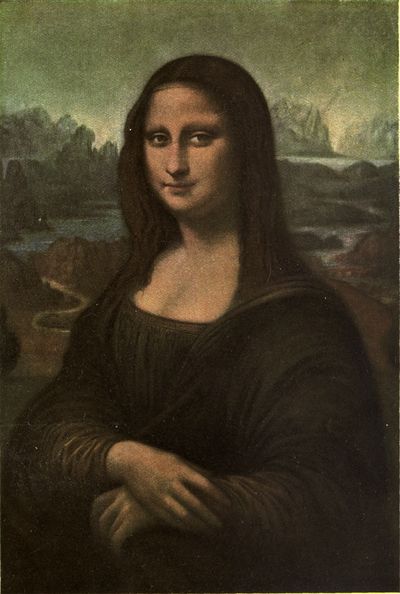
Leonardo Da Vinci: Monna Lisa
(Formerly Paris: The Louvre, 1601. Canvas on Panel)
Leonardo had very great spirit, and in his every action was most generous. It is said that, going to the bank for the allowance that he used to draw every month from Piero Soderini, the cashier wanted to give him certain paper-packets of pence; but he would not take them, saying in answer, “I am no penny-painter.” Having been blamed for cheating Piero Soderini, there began to be murmurings against him; wherefore Leonardo so wrought upon his friends, that he got the money together and took it to Piero to repay him; but he would not accept it.
He went to Rome with Duke Giuliano de' Medici, at the election of Pope Leo, who spent much of his time on philosophical studies, and particularly on alchemy; where, forming a paste of a certain kind of wax, as he walked he shaped animals very thin and full of wind, and, by blowing into them, made them fly through the air, but when the wind ceased they fell to the ground. On the back of a most bizarre lizard, found by the vine-dresser of the Belvedere, he fixed, with a mixture of quicksilver, wings composed of scales stripped from other lizards, which, as it walked, quivered with the motion; and having given it eyes, horns, and beard, taming it, and keeping it in a box, he made all his friends, to whom he showed it, fly for fear. He used often to have the guts of a wether completely freed of their fat and cleaned, and thus made so fine that they could have been held in the palm of the hand; and having placed a pair of blacksmith’s bellows in another room, he fixed to them one end of these, and, blowing into them, filled the room, which was very large, so that whoever was in it was obliged to retreat into a corner; showing how, transparent and full of wind, from taking up little space at the beginning they had come to occupy much, and likening them to virtue. He made an infinite number of such follies, and gave his attention to mirrors; and he tried the strangest methods in seeking out oils for painting, and varnish for preserving works when painted.
He made at this time, for Messer Baldassarre Turini da Pescia, who was Datary to Pope Leo, a little picture of the Madonna with the Child in her arms, with infinite diligence and art; but whether through the fault of whoever primed the panel with gesso, or because of his innumerable and capricious mixtures of grounds and colours, it is now much
spoilt. And in another small picture he made a portrait of a little boy, which is beautiful and graceful to a marvel; and both of them are now at Pescia, in the hands of Messer Giuliano Turini. It is related that, a work having been allotted to him by the Pope, he straightway began to distil oils and herbs, in order to make the varnish; at which Pope Leo said: “Alas! this man will never do anything, for he begins by thinking of the end of the work, before the beginning.”
There was very great disdain between Michelagnolo Buonarroti and him, on account of which Michelagnolo departed from Florence, with the excuse of Duke Giuliano, having been summoned by the Pope to the competition for the façade of S. Lorenzo. Leonardo, understanding this, departed and went into France, where the King, having had works by his hand, bore him great affection; and he desired that he should colour the cartoon of S. Anne, but Leonardo, according to his custom, put him off for a long time with words.
Finally, having grown old, he remained ill many months, and, feeling himself near to death, asked to have himself diligently informed of the teaching of the Catholic faith, and of the good way and holy Christian religion; and then, with many moans, he confessed and was penitent; and although he could not raise himself well on his feet, supporting himself on the arms of his friends and servants, he was pleased to take devoutly the most holy Sacrament, out of his bed. The King, who was wont often and lovingly to visit him, then came into the room; wherefore he, out of reverence, having raised himself to sit upon the bed, giving him an account of his sickness and the circumstances of it, showed withal how much he had offended God and mankind in not having worked at his art as he should have done. Thereupon he was seized by a paroxysm, the messenger of death; for which reason the King having risen and having taken his head, in order to assist him and show him favour, to the end that he might alleviate his pain, his spirit, which was divine, knowing that it could not have any greater honour, expired in the arms of the King, in the seventy-fifth year of his age.
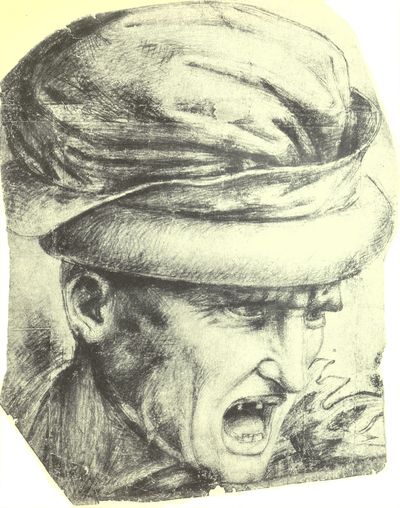
Fragment from “The Battle Of The Standard”
(After the cartoon attributed to Leonardo da Vinci. Oxford: Ashmolean Museum)
Reproduced by permission of the Visitors of the Ashmolean Museum
The loss of Leonardo grieved beyond measure all those who had known him, since there was never any one who did so much honour to painting. With the splendour of his aspect, which was very beautiful,
he made serene every broken spirit: and with his words he turned to yea, or nay, every obdurate intention. By his physical force he could restrain any outburst of rage: and with his right hand he twisted the iron ring of a door-bell, or a horse-shoe, as if it were lead. With his liberality he would assemble together and support his every friend, poor or rich, if only he had intellect and worth. He adorned and honoured, in every action, no matter what mean and bare dwelling; wherefore, in truth, Florence received a very great gift in the birth of Leonardo, and an incalculable loss in his death. In the art of painting, he added to the manner of colouring in oils a certain obscurity, whereby the moderns have given great force and relief to their figures. And in statuary, he proved his worth in the three figures of bronze that are over the door of S. Giovanni, on the side towards the north, executed by Giovan Francesco Rustici, but contrived with the advice of Leonardo; which are the most beautiful pieces of casting, the best designed, and the most perfect that have as yet been seen in modern days. By Leonardo we have the anatomy of the horse, and that of man even more complete. And so, on account of all his qualities, so many and so divine, although he worked much more by words than by deeds, his name and fame can never be extinguished; wherefore it was thus said in his praise by Messer Giovan Battista Strozzi:
Vince costui pur solo
Tutti altri; e vince Fidia e vince Apelle
E tutto il lor vittorioso stuolo.
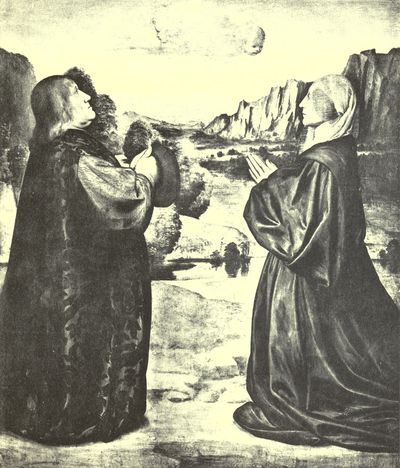
Man and Woman Praying
(After the panel by Giovan Antonio Boltraffio. Milan: Brera, 281)
Anderson
A disciple of Leonardo was Giovan Antonio Boltraffio of Milan, a person of great skill and understanding, who, in the year 1500, painted with much diligence, for the Church of the Misericordia, without Bologna, a panel in oils containing Our Lady with the Child in her arms, S. John the Baptist, S. Sebastian naked, and the patron who caused it to be executed, portrayed from the life, on his knees—a truly beautiful work, on which he wrote his name, calling himself a disciple of Leonardo. He has made other works, both at Milan and elsewhere; but it must be enough here to have named this, which is the best. Another (of his disciples) was Marco Oggioni, who painted, in S. Maria della Pace, the Passing of Our Lady and the Marriage of Cana in Galilee.





